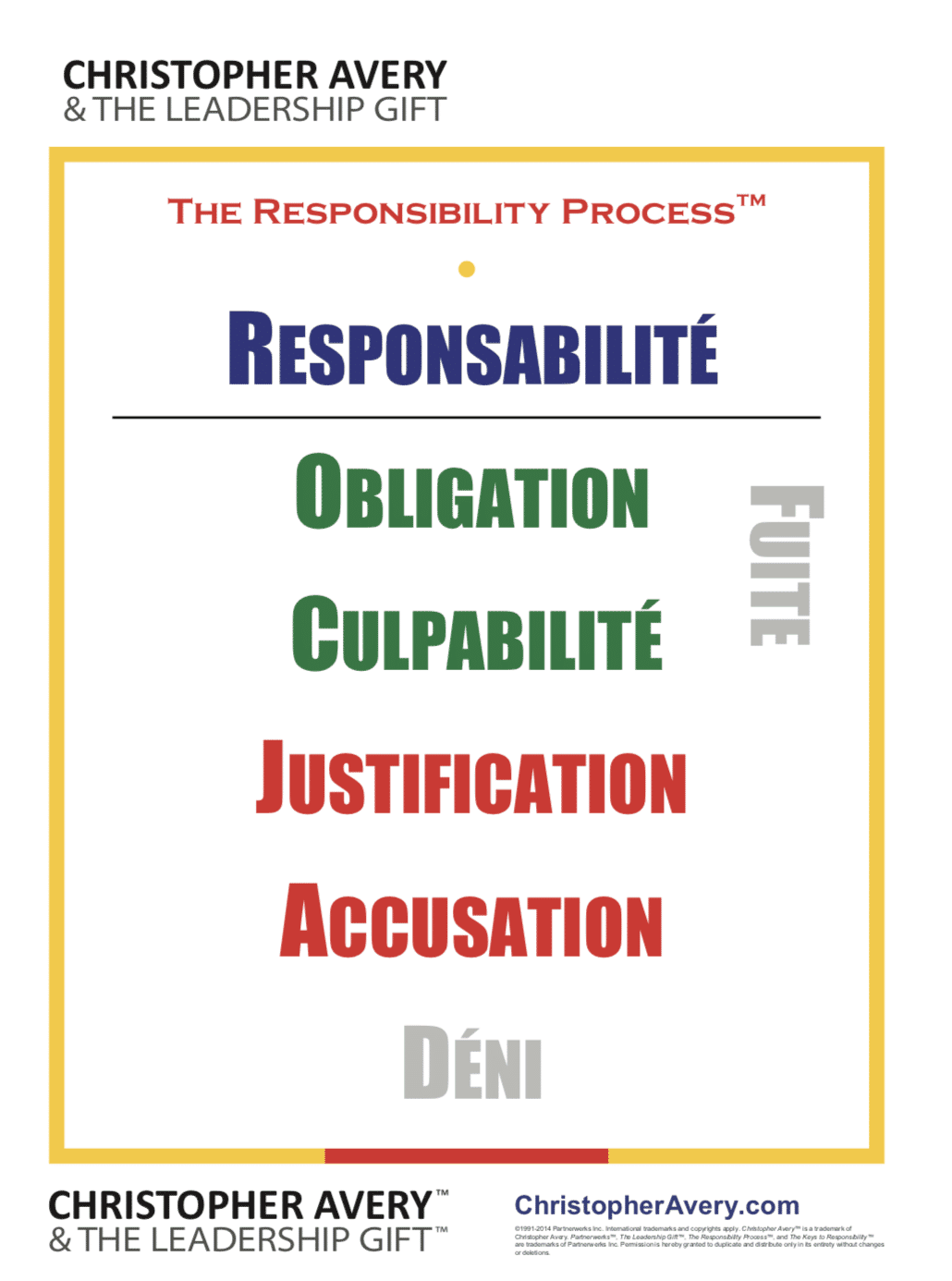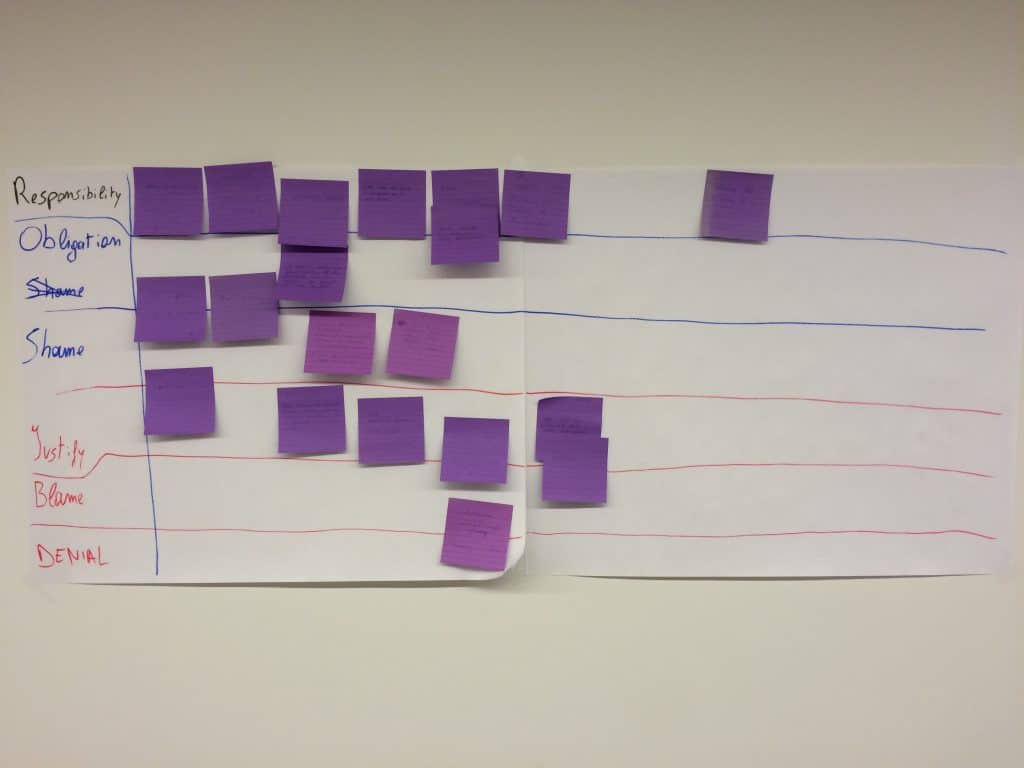En approfondissement le sujet du Processus de Responsabilité, je comprends de mieux en mieux comment me l’appliquer à moi-même afin d’être plus libre dans mes choix et mes actions. La question que je me pose souvent est plutôt comment je pourrais le mettre en oeuvre dans le cadre d’une transformation Agile. J’ai eu l’occasion de le tester dans le cadre d’une rétrospective de communauté mais je ne l’ai pas encore inscrit dans une démarche structurée d’accompagnement.
Au travers de mes recherches, je suis tombé sur un article de Christopher Avery parlant des connections entre Agilité et le Processus de Responsabilité. Je vous en propose une traduction, avec son accord, afin d’explorer ensemble le sujet au travers d’un prisme différent.
Bonne lecture ! 🙂
[Traduction]
Vos efforts de mise en oeuvre de l’Agilité manquent de quelque chose, et vous n’arrivez pas à mettre le doigt dessus ? Peut-être que le Processus de Responsabilité peut vous aider.
Aucun secteur business n’a adopté aussi largement le Processus de Responsabilité (décrit ci-dessous) que les communautés Agile/Lean/Scrum/Kanban/XP (désormais, « agile » ou « agilité »).
Pourquoi ?
Car cela convient très bien. Le Processus de Responsabilité est un outil de self-leadership puissant et organique pour assumer ses responsabilités et revendiquer la liberté, le choix, et le pouvoir qui vient avec. C’est un brillant langage commun pour l’appropriation et la non-appropriation, tout comme un élégant outil créateur de sens.
Chacun de ces pourquois parlent directement aux valeurs et aux principes fondamentaux de l’agilité.
De nombreux leaders et coachs agiles estiment le Processus de Responsabilité comme précieux dans leur propre agilité ainsi que pour construire des équipes, des leaders et des cultures agiles. En parlant du Processus de Responsabilité, un client travaillant dans le développement du leadership agile a écrit :
Je suis vraiment impressionné par sa profondeur, sa puissance et sa subtilité.
Cependant, pour beaucoup de leaders et de coachs agiles, ce que le Processus de Responsabilité peut leur offrir n’est pas du tout clair. Cet article est une tentative pour rendre plus explicite les connections entre l’agilité et le Processus de Responsabilité.
Dans cet article, je vais assumer que vous êtes familiers avec le mouvement Agile en rapide expansion dans le domaine du logiciel, de la gestion de projet, le développement de produit, et le business. Dans le cas contraire, le Hacker Chic offre une rapide vue d’ensemble.
Le Processus de Responsabilité est loin d’être aussi connu que l’agilité. Je le décrirais rapidement, puis pointerais 9 connections spécifiques avec l’agilité.
Qu’est-ce que le Processus de Responsabilité ?

La puissance du modèle est qu’il change la conversation de morale et de caractère autour de la responsabilité, en une conversation d’apprentissage et d’épanouissement.
Le processus, ou pattern, est déclenché lorsque quelque chose se passe mal, même de petites choses :
- une voiture s’arrête juste devant vous,
- un membre critique de l’équipe saute une réunion importante,
- il ne reste plus de café.
Puisque la vie et le travail semblent rarement parfaits, ce pattern mental est assez souvent actif en chacun de nous.
Chaque position dans la séquence est un état mental avec sa propre logique de cause à effet. Lorsque l’on traite nos pensées au sujet de problèmes, on commence (inconsciemment et naturellement) d’abord en bas, où la logique de cause à effet est simpliste et l’effort de computation est faible. Si l’on aime (c’est-à-dire, accepte) la réponse que notre esprit nous offre (C’est sa faute!), on s’installe dans la logique simpliste de cause à effet de cet état mental.
Par exemple, dans l’Accusation, on est sûr que quelqu’un d’autre doit changer pour que le problème s’en aille. Si l’on n’accepte pas la réponse que notre esprit nous offre, alors on monte dans la séquence. Alors assumer sa responsabilité est l’acte de courage ultime de refus d’accepter les tentatives de notre esprit à nier, accuser, justifier, se culpabiliser, ou se sentir piégé dans l’obligation.
Il n’y a que dans l’état mental de Responsabilité que l’on libère notre esprit pour accéder à nos chemins de raisonnements créatifs et complexes pour apprendre, grandir, et dépasser le problème. En termes Lean, on dit que sous la ligne la pensée et l’action sont gaspillées; au-dessus de la ligne repose la pensée et l’action de valeur.
Bien sûr, il y a beaucoup de « profondeur, puissance, et subtilité » derrière cette brève introduction. Recherchez « The Responsibility Process » pour trouver d’autres ressources. Cherchez particulièrement celles postées par des agilistes.
Note : ça tombe bien, j’en ai 2 à vous proposer ! 🙂 |
Agilité et réactivité
Dès lors qu’un praticien agile progresse, il voit souvent les outils, processus et méthodologies Agile comme la partie simple de l’agilité. Ce sont les personnes, la culture et le leadership qui peuvent être les plus challengeants. C’est là que le Processus de Responsabilité intervient.
Le Processus de Responsabilité représente une compétence meta, les connections avec l’agilité sont donc aussi meta, plus au niveau des principes que des pratiques. Cette qualité meta est la puissance du Processus de Responsabilité que tant d’agilistes reconnaissent. C’est un outil exceptionnel pour le self-leadership. C’est un outil inutile pour contrôler les gens ou les processus.
Voici certaines des connections spécifiques que je vois pour les leaders et coachs agiles avec le Processus de Responsabilité à mettre en oeuvre dans leur pratique quotidienne.
Auto-organisation orientée résultats

En tant qu’outil créateur de sens (« sense-making »), le Processus de Responsabilité peut ajouter de la fluidité significative dans les pensées et actions des équipes, programmes et entreprises agiles. Un article de la Scrum Alliance au sujet des valeurs fondamentales de Scrum déclare que :
… la responsabilité de l’équipe dans Scrum est critique.
Mais pour atteindre la responsabilité d’équipe, on veut que les individus opèrent de l’état mental de Responsabilité afin de pouvoir faire sens des obstacles, des conflits, et des contrariétés. Les leaders et coachs agiles qui promeuvent le Processus de Responsabilité dans leurs équipes disent que c’est une force extrêmement positive pour l’auto-organisation.
En pensant à l’agilité et l’auto-organisation, posez ces questions :
- Où sommes-nous dans le Processus de Responsabilité lorsque les choses ne semblent pas correctes ?
- Combien de temps et d’énergie gaspillons-nous dans les états d’adaptation ?
- Savons-nous comment ce pattern fonctionne dans notre esprit et comment pratiquer la responsabilité afin de revenir rapidement à des pensées et actions pertinentes ?
Appropriation et confrontation des impédiments

Les plus gros problèmes se trouvent entre les silos plutôt qu’au sein même des silos (quelque soit leur taille : rôles, équipes, fonctions, organisations). Les addresser s’agit de mettre la responsabilité personnelle et partagée avant la responsabilité des rôles (au sens accountability).
Un manque d’appropriation persiste dans la plupart des organisations où les personnes sont focalisées sur leurs rôles individuels plutôt que d’optimiser l’ensemble. Cela est évident dans les approches chiffrées de processus agiles où les personnes peuvent être rebutées à l’idée de confronter les impédiments. Au lieu de cela, elles les ignorent ou les cachent, choisissant de faire avec plutôt que d’y faire face et de se les approprier.
Lorsque des groupes de personnes adoptent et pratiquent le Processus de Responsabilité ensemble, ils tendent à être bien plus collaboratifs, mutuellement soutenants, et holistiques dans leur approche de résolution de problèmes. Ils sont conscients de leurs propres limites de pensée. Pratiquer la responsabilité via le Processus de Responsabilité amène souvent à la pensée du « ensemble on est assez » et à proposer de jouer à un jeu ayant plus de valeur.
Une culture et un état d’esprit d’appropriation fleurissant

Les leaders et coachs agiles utilisent le Processus de Responsabilité comme un outil pour la résolution de problèmes, pour avoir un langage commun autour des problèmes et des challenges, et comme un principe fondamental d’organisation d’équipe ou d’une communauté plus large. Le tout afin de promouvoir la responsabilité personnelle et partagée ainsi que le leadership. C’est un outil puissant de création de culture.
Voici une recommandation d’un coach agile à d’autres dans sa société à étudier et appliquer le Processus de Responsabilité. Alors qu’il parle spécifiquement de leur implication dans une communauté eLearning appelée The Leadership Gift Program, j’ai enlevé une grande partie de son commentaire afin de nous focaliser sur le Processus de Responsabilité.
Le travail de Christopher a transformé en profondeur la manière dont j’ai travaillé avec mes clients bien avant qu’il ne débute ce programme et j’en suis arrivé à le considérer comme un ami personnel. J’ai encouragé Christopher à trouver un moyen de scaler son travail afin qu’il ne nécessite pas de présence locale – en partie parce-que le monde a besoin de son travail, et en partie parce-que j’avais d’autant plus besoin de son aide. Lorsqu’il a lancé sa première session à distance, j’ai immédiatement sauté sur l’occasion.
Ayant partagé mes biais, je renforcerai ma déclaration initiale avec ces affirmations :
Maitriser la responsabilité personnelle est la base du programme d’Avery. Je pense que c’est également la compétence la plus fondamentale pour se comporter de manière agile. Tous les outils que je peux proposer à un client sont négligés si ce client opère de manière non responsable. Ma capacité à les aider dépend de ma capacité à les aider à retourner dans un lieu de responsabilité personnelle. Le programme d’Avery est inestimable, peut-être indispensable, pour quiconque est impliqué dans le coaching.
Le Processus de Responsabilité est l’outil de coaching le plus utile que j’ai trouvé.
—Ashley Johnson, Agile Coach, Industrial Logic
Plus d’humanité et de respect

Le Processus de Responsabilité nous montre que les personnes ne sont pas mauvaises ou incorrectes de blâmer ou de faire avec leurs problèmes plutôt que de se les approprier et de les adresser, elles sont humaines. Et les humains sont câblés pour faire avec lorsque l’on ne sait pas comment grandir. Cette prise de conscience génère de la compassion, de l’empathie, et de l’écoute. Tout cela amène de l’humanité, de l’appartenance et de la positivité dans les organisations agiles.
Lorsque les leaders dans un système arrêtent de blâmer les gens, ils commencent à assumer leurs responsabilités pour le système qu’ils ont créé. Ils réalisent que pour changer les choses, ils doivent changer eux-mêmes ainsi que le système afin que les personnes puissent prospérer et être utiles.
Le Processus de Responsabilité est un outil exceptionnel pour soutenir les leaders dans leur compréhension et le changement d’eux-même et du système. De nombreux leaders, de chef d’équipe à CEO appellent le Processus de Responsabilité la sauce secrète dans leur système.
Un leadership partagé inspirant

Le leadership est souvent défini comme la prise de responsabilité pour quelque chose qui est plus grand que vous, et en le faisant, inspirant les autres à vous rejoindre dans cette poursuite. Alors le leadership n’est pas un titre, une position, une autorité, ou un statut. C’est l’appropriation d’un problème, d’une opportunité, ou du changement, et la mobilisation des autres pour aider au travers d’une vision, d’une finalité et d’une communauté.
L’agilité et le Processus de Responsabilité promeuvent tous deux plus de leadership, pas nécessairement plus de leaders.
Peter Koestenbaum, le philosophe institutionnel distingué, a écrit longuement sur l’esprit du leadership et sur la responsabilité personnelle. Le paragraphe suivant est un extrait de l’un de ses Weekly Leadership Thought (emails auxquels je recommande de s’abonner)) intitulé Do You Choose to Activate Your Freedom?
L’essence d’un être humain est ce noyau non matériel, non biologique de liberté, cet éclat divin de lumière à l’intérieur de votre corps. […] Être humain c’est accueillir cette liberté à l’intérieur, mais être un leader c’est avoir choisi, avec cette même liberté, d’affirmer la puissance de la liberté, de se l’approprier, et consciemment et délibérément l’activer dans tout ce que vous faites.
Rien n’arrive à moins que vous ne le déclenchiez. Votre responsabilité est étendue. Où que vous vous trouviez, votre sphère d’influence, votre capacité à affecter les événements, à faire avancer les choses, vont bien au-delà du son de votre voix et de la portée de vos yeux.
Je crois que le leadership agile appelle à choisir et à s’approprier cette lueur à l’intérieur. Pratiquer le Processus de Responsabilité va dans la direction de faire briller la lumière en soi et en les autres.
De meilleures prises de décision et de résolutions de problème

Assumer ses responsabilités vous met dans une position de pro-activité dans la reconnaissance, la génération et le choix d’options. Les agilistes qui pratiquent le Processus de Responsabilité rapportent avoir expérimenté une plus grande clarté et un plus grand choix autour de leurs décisions.
Aucun problème ne trouve solution tant que quelqu’un ne se l’approprie. Dans les états d’adaptation, on reconnaît et on adresse rarement le vrai problème. Les personnes pratiquant la responsabilité savent qu’ils ont soit à s’approprier le problème soit à s’approprier les conséquences.
Une meilleure prise de décision et résolution de problème se traduit par des expérimentations plus rapides, de l’apprentissage, de la correction, et de la prise d’actions efficaces.
S’épanouir dans le changement

L’agilité est la capacité à changer sans changer. C’est-à-dire, la capacité à changer ce que l’on fait sans changer qui l’on est et ce que l’on défend. C’est une problématique de focus, une valeur de Scrum. Dans l’état mental de responsabilité le changement est naturel et facile; dans tous les états d’adaptation en dessous de la ligne, on résiste au changement.
Pratiquer la responsabilité via le Processus de Responsabilité signifie pratiquer le changement et la réactivité plutôt que la rigidité et la résistance.
Réflexion et feedback appréciatifs

De nombreuses équipes exécutent un travail en altérant ou en faisant abstraction des opportunités de feedback et d’apprentissage présentes.
Certaines des meilleures applications du Processus de Responsabilité sont avec des leaders et coachs agiles qui facilitent l’équipe à vraiment s’approprier les dynamiques de feedback, de réflection et d’apprentissage.
Voici un exemple, un article de blog de Tim Schraepen offrant des pistes d’utilisation du Processus de Responsabilité dans une rétrospective.
Appel à la pratique

L’agilité, et tout particulièrement le leadership agile, appelle à agir de notre esprit créatif, libre et puissant plutôt que de notre esprit réactif, pour répondre et s’adapter à chaque moment de notre vie et de notre business. Le Processus de Responsabilité vous offre un outil qui est déjà en vous, un outil pour activer et faire grandir votre capacité de leadership innée, pour ensuite aider les autres à la découvrir également.
Connaître le Processus de Responsabilité est fun et inspirant, cependant le connaître ne suffit pas. Le Processus de Responsabilité ne fonctionnera pour vous que si vous le mettez en pratique. Comment commencer ? Télécharger un poster PDF en couleur du Processus de Responsabilité, disponible en 27 langues. Imprimez le et affichez le où vous pourrez le voir souvent. Puis commencez à remarquer vos propres états mentaux. Cherchez un collègue, ou 2 ou 3, qui l’étudiera et l’appliquera avec vous. Partagez cet article avec les personnes à qui vous tenez et démarrez une discussion. Lorsque vous serez prêts à aller plus loin, il y a beaucoup de ressources disponibles pour vous soutenir.
Cela va changer votre vie.
Merci d’avoir lu cet article. Vos commentaires et questions sont les bienvenus. Je suis sûr qu’il y a des connections que j’ai oubliées ou que je n’ai pas expliqué aussi bien que j’aurais pu. Et je parie que d’autres pourront offrir différentes perspectives.
Christopher Avery, “The Responsibility Process guy”, a fondé The Leadership Gift™ Program pour rendre le développement du leadership personnel de classe mondiale accessible aux individus dans le monde entier. Ses livres incluent The Responsibility Process et Teamwork Is An Individual Skill.







